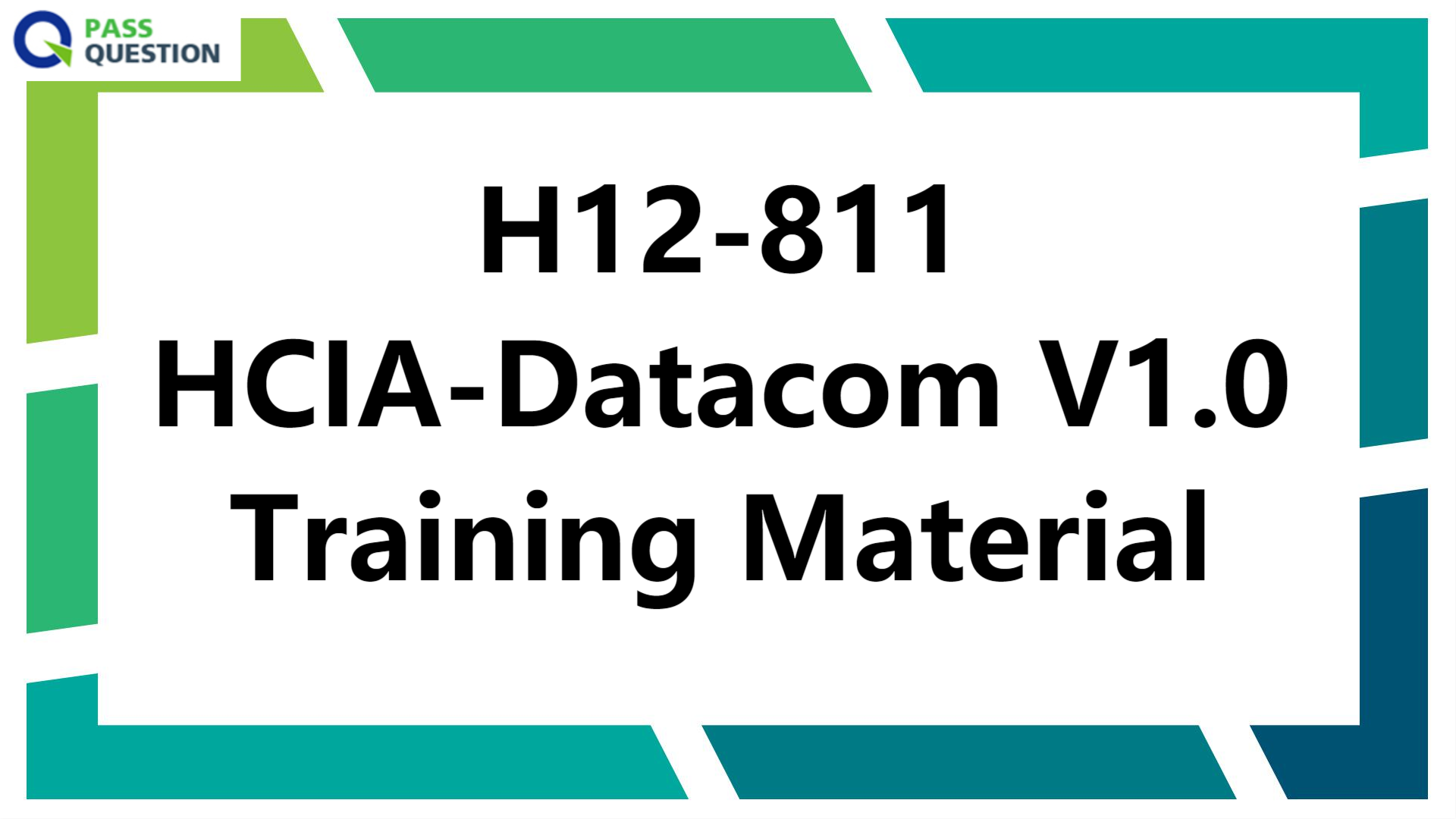2021 New H12-811 HCIA-Datacom V1.0 Training Material
There are many ways to help you pass Huawei H12-811 exam. PassQuestion can provide you H12-811 HCIA-Datacom V1.0 Training Material and high-quality reference information for you to participate in the Huawei H12-811 exam.Therefore, the high quality and high authoritative H12-811 HCIA-Datacom V1.0 Training Material provided by PassQuestion can definitely do our best to help you pass Huawei H12-811 exam. PassQuestion will continue to update the information about HCIA-Datacom V1.0 H12-811 exam to meet your need.

Huawei HCIA-Datacom V1.0 Certification
Passing the HCIA-Datacom V1.0 certification will indicate that you are capable of planning, design, deployment, O&M, and optimization of small- and medium-sized campus networks.HCIA-Datacom V1.0 includes the following contents: Routing and switching principles, basic WLAN principles, basic knowledge of network security, basic knowledge of network management and O&M, and basic knowledge of SDN and programming automation.

HCIA-Datacom V1.0 Exam Content
The HCIA-Datacom V1.0 exam covers:
- Basic knowledge of the TCP/IP protocol stack
- Basic principles of the Open Shortest Path First (OSPF) routing protocol and its implementation in Huawei routers
- Ethernet technology, spanning tree, VLAN, stacking technology and their implementation in Huawei switches
- Network security technology and their implementation in Huawei routing and switching devices
- WLAN technologies and basic principles and their implementation on Huawei wireless devices;
- Basic principles of network management (such as SNMP)
- Basic principles of WAN protocols (such as PPP) and their implementation on Huawei routers
- Basic knowledge of IPv6 and basic principles and implementation of ICMPv6 and DHCPv6
- Basic principles of SDN and implementation of Huawei products and solutions
- Basic principles of programming automation
Exam Knowledge Points
1. Data communication and network basics 8%
2. Build an IP network with interconnection and interworking 27%
3. Ethernet switching network construction 28%
4. Cyber security infrastructure and network access 8%
5. Network services and applications 5%
6. WLAN basics 10%
7. WAN basics 3%
8. Network management and O&M 3%
9. IPv6 basics 5%
10. SDN and automation basics 3%
1 Data communication and network basics
- 1.1 Basic Knowledge of Routing and Switching
- 1.2 Basic network concepts, IP network architecture, and standardization organizations and protocols
- 1.3 OSI and TCP/IP protocol models, functions of each layer, and packet encapsulation
- 1.4 ARP Principles
- 1.5 TCP/UDP Principles
- 1.8 Data Forwarding Process
- 1.9 Basic Concepts and Life Cycle of Campus Network
- 1.10 Basic Principles and Operations of the VRP
2 Build an IP network with interconnection and interworking
- 2.1 IPv4 basics (basic concepts, address classification, and subnet division)
- 2.2 Basics of IP Routing and Forwarding Principles of Layer 3 Devices
- 2.3 Principles of the static routing, basic principles of the OSPF protocol, and implementation in the VRP
- 2.4 How to use static route and OSPF technologies to build small-sized routing network in Huawei Router.
3 Ethernet switching network construction
- 3.1 Ethernet technology and basic principles of switches
- 3.2 STP, RSTP, and VLAN Principles and Implementation in the VRP
- 3.3 Basic principles and configuration of technologies such as link aggregation and stacking
- 3.4 How to use technologies such as STP, RSTP, and VLAN to build a small-scale switching network.
4 Cyber security infrastructure and network access
- 4.1 Basic Principles and Configuration Methods of ACLs
- 4.2 AAA Principles and Application Scenarios
- 4.3 Basic Principles of NAT
- 4.4 NAT Application Scenarios and Configuration Methods
5 Network services and applications
- 5.1 Basic Principles of Telnet, FTP, TFTP,DHCP,DNS,NTP, and HTTP
- 5.2 Configuration of FTP,DHCP and Telnet
6 WLAN basics
- 6.1 Basic Concepts of WLAN (802.11 Protocol Family, Basic Devices, and Basic Networking)
- 6.2 WLAN Basic Working Process
- 6.3 Basic WLAN Configuration
7 WAN basics
- 7.1 Basic WAN Concepts
- 7.2 PPP and PPPoE Configuration
- 7.3 Basic Concepts of MPLS/SR
8 Network management and O&M
- 8.1 Basic Concepts of Network Management
- 8.2 SNMP Protocol Basics
- 8.3 Basic Concepts of Huawei SDN Solution
9 IPv6 basics
- 9.1 IPv6 basics (address format , packet format, and address classification)
- 9.2 IPv6 Address Configuration Method and Process
- 9.3 IPv6 Static Route Configuration
10 SDN and automation basics
- 10.1 Basic SDN Concepts and Huawei Products and Solutions
- 10.2 Basic NFV Concepts and Huawei Products and Solutions
- 10.3 Basic Concepts of Automatic O&M
- 10.4 Python Basics
View Online HCIA-Datacom V1.0 H12-811 Free Questions
Huawei ARG3 series routers have all versions of SNMP (SNMPv1, SNMPv2c and SNMPv3) by default.
A.True
B.False
Answer: A
IPv6 address 2001: ABEF: 2240E: FFE2: BCC0: CD0: DDBE: 8D58 cannot be abbreviated.
A.True
B.False
Answer: A
Which state does the OSPF protocol use to indicate that the adjacency relationship has been established?
A.Full
B.2-way
C.Attempt
D.Down
Answer: A
The tracert diagnostic tool in Huawei routers is used to track the data forwarding path.
A.True
B.False
Answer: A
Which of the following does not include the advantages of Wi-Fi 6 compared to Wi-Fi 5?
A. Higher bandwidth
B. Lower transmission delay
C. Higher power consumption
D. Higher number of access terminals per AP
Answer: C
- TOP 50 Exam Questions
-
Exam
All copyrights reserved 2025 PassQuestion NETWORK CO.,LIMITED. All Rights Reserved.

